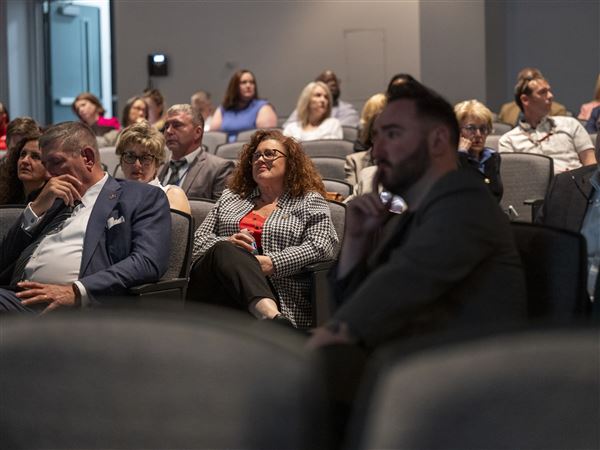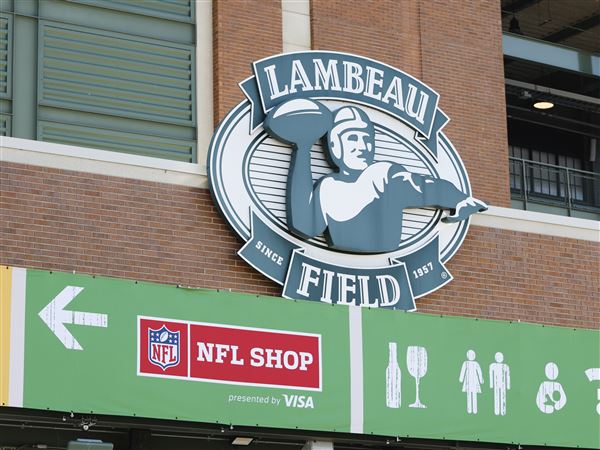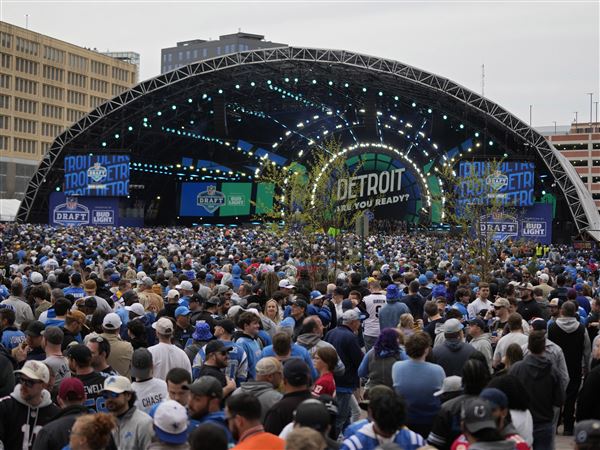Tai Sing Lee is the new face of Pittsburgh.
On March 28, the 52-year-old Carnegie Mellon University researcher became one of 87 freshly minted citizens in Pittsburgh, taking his oath of allegiance in the lofty auditorium of Soldiers & Sailors Memorial Hall and Museum.
The new U.S. citizens that day came from 40 nations and all walks of life. But in some ways, Mr. Lee is the embodiment of Pittsburgh's recent immigration.
Pittsburgh is known as a city of immigrants, but that's usually a reference to the late 1800s and early 1900s, when hundreds of thousands of workers and their families flooded into the region from eastern and southern Europe.
Much less well known is the influx that Pittsburgh has experienced over the past 40 years. That wave of newcomers has been dominated by highly educated immigrants from east and south Asia, and Mr. Lee is emblematic of that.
Raised in Hong Kong, he is a renowned scientist studying the human visual system at the Center for the Neural Basis of Cognition, a joint Carnegie Mellon-University of Pittsburgh institution.
Pittsburgh's universities, particularly Pitt and Carnegie Mellon, have been major magnets for the new immigrants. So have the medical complexes at UPMC and Allegheny Health Network, as well as high-tech companies, from Google's Pittsburgh operation to fledgling startups.
As a result, the Pittsburgh region has one of the highest-educated groups of immigrants in the nation.
An analysis by the Brookings Institution shows that as of 2009, nearly 54 percent of Pittsburgh's immigrants were highly skilled workers, the highest level of any of several former immigrant magnet cities, including St. Louis; Buffalo, N.Y.; Cleveland; and Detroit.
What Pittsburgh lacks
But there is another reason that skill level is so lofty, and it reflects some of Pittsburgh's disadvantages.
Pittsburgh has been much less successful than other cities in drawing lower-skilled immigrants: the laborers, kitchen workers, landscapers, roofers and other foreign-born employees who have poured into the Sun Belt, but also make up a bigger proportion of immigrants in other Rust Belt cities.
In looking at immigrants who have arrived in the United States since 2000, 55 percent have come from Mexico and Central and South America. In Pittsburgh, that figure is 17 percent.
In one chart prepared by Pitt demographer Christopher Briem that examines net immigration between 2012 and 2013 in 40 American cities, Pittsburgh was next to last, trailing not only immigrant hot spots like Miami and New York, but also other aging Midwestern cities like Milwaukee, Cincinnati and Indianapolis.
Mr. Briem has a theory on why our numbers have been so low.
When Pittsburgh's steel mills and related industries crumbled in the late 1970s, he said, it is likely that the most skilled and ambitious former mill workers left the region to find other jobs, and the ones who stayed behind vacuumed up the lower-wage jobs that slowly became available over the next 20 years -- the very work that has been done by immigrants in other cities.
To grasp Pittsburgh's reality in 2014, he said, "you still have to understand what happened 30 years ago, and in reality, our job loss was far worse than for other industrial cities. So we have this mass of never-again fully employed workers who only now are leaving their prime working ages. To the degree there was any job growth here, it was probably taken up by these displaced workers."
Or, more anecdotally, he put it this way:
"I was standing in front of a school bus stop in Oakland the other day and I watched 20 buses go by. If you were anywhere else in the country, a decent chunk of those drivers would probably be immigrants or minorities, and I swear to God, every one of them was a 55-year-old white guy, that barring historical events would have been working in a mill."
Donna Gabaccia, a history professor at the University of Minnesota who once taught at Pitt, agreed with Mr. Briem's theory.
"One of the things that struck me when I first moved to Pittsburgh from Charlotte, N.C., which had experienced its very first significant immigration in the 1980s and 1990s, was that Charlotte was more diverse than Pittsburgh, which really surprised me.
"When you come to Pittsburgh's airport, you have a native English speaking black or white taxi driver, and in almost every other city that would not be the case."
After the steel mill collapse, said Audrey Russo, president of the Pittsburgh Technology Council, "there was no growth and there were no jobs for people to be drawn here. The displaced workers tended to pick up the jobs that became available. And if you don't have population growth you can't have exponential growth" in immigrants.
While Pittsburgh has benefited from its highly accomplished newcomers from India, China and elsewhere, that stratum of new residents is not enough by itself to create a vital economy, argued Richard Herman, a Cleveland immigration lawyer and activist.
"If a region tries to build only a high-skill society," he said, "it's like having a head with no body. To truly be a dynamic, vibrant community, you really need all these pieces at the same time," including entry-level immigrant workers.
What the numbers show
Despite our somewhat one-sided immigration, the statistics show some interesting trends.
In 1980, Asians made up about 10 percent of the Pittsburgh region's foreign-born population. By 2010, they constituted 45 percent of them.
In Allegheny County, the two biggest Asian groups, as in many other parts of the U.S., are the Indians and the Chinese. As of 2010, the county had nearly 5,600 Chinese residents, which was 14 times greater than in 1980. The Indian presence was even more robust. In 2010, there were about 11,370 Indians living here, about eight times more than in 1980.
Hispanics, who comprise 17 percent of the nation's population today, made up less than 1 percent of the region's population overall in 2010, and represented only 15 percent of all foreign-born residents.
The first big wave of Asian immigrants came here in the 1960s and 1970s, when the former Westinghouse Electric Co. nuclear research operations in Monroeville hired many Indian engineers, and the regions' hospitals and universities began to recruit Indians as professors and doctors.
A later surge of Indian immigrants arrived in the 1980s and '90s to work as computer scientists for companies like Mastech, founded by Indian-American entrepreneur Sunil Wadhwani.
Over that time, immigrants from Japan, China, South Korea, Taiwan and other east Asian nations also flowed into the region to work as university researchers and physicians, just as immigrants from Nigeria, Kenya, Greece, Turkey, Russia and Lebanon established restaurants and other businesses here.
Those migrations have been followed more recently by refugee groups from Somalia in Africa and Bhutan in Asia.
A scientist's story
Like many other Asian newcomers to Pittsburgh, Tai Sing Lee's path was shaped by a meritocratic education system.
His father was a journalist and translator of English books. Like many other educated Chinese, he was caught up in the Cultural Revolution of the late 1960s and early 1970s and forced to do manual labor in the countryside.
Mr. Lee was a boy then and stayed with his mother in Guangzhou until the family was able to move to Hong Kong, partly because of the influence of Mr. Lee's grandfather, a noted physician there who was respected for his charity work among the poor.
When he arrived in Hong Kong at age 11, he recalled, he was near the bottom of his class academically, but emulating his father and mother, both of whom were employed in publishing houses, he worked hard and rose in class rank at Queens College, a college preparatory school that trains many of Hong Kong's government officials, lawyers, doctors and architects.
His interest in science began when his mother paid him to proofread a Chinese translation of a biography of Marie Curie, the Nobel Prize winner.
"The proofreading forced me to read that book three times. And that sort of inspired me about science, and also the struggle of Madame Curie for knowledge and her ideals was very romantic and heroic to me," he said in a recent interview.
His parents invested their savings to send him to America to finish high school in Massachusetts, and he was then accepted into Harvard, where he studied engineering physics and became interested in computer science and biology.
He went on to get his Ph.D. in health science and technology from Harvard and the Massachusetts Institute of Technology. Knowing he wanted to use his math and computer skills to study biology and medicine, he eventually found a mentor in David Mumford, now an emeritus professor at Harvard and Brown universities and a 2010 winner of the National Medal of Science.
Together, they developed a theory about how the brain's visual centers use internal models to help us synthesize clear images from the "noisy" signal we get from our retinas. That work led Carnegie Mellon to recruit Mr. Lee in 1996. It was here that he met his wife, Japanese-born Tomoko Nukui, who is a cancer researcher at Pitt. They have two children.
The CMU researcher acquired permanent residency status in the U.S. several years ago, but it was not until two recent events in his life that he began to think seriously about becoming a U.S. citizen.
The first was a period when he taught in the Middle East.
"Even though I was treated very well there, you feel this strong sense of hierarchy and that people are not equal. Some are born to privilege and others go to that country to work and will remain at the bottom of the society.
"You feel America is really open and you feel the liberty and freedom and democracy [that exist here]. When you have it all the time, you take it for granted. So when I came back," he said, his voice thickening, "I raised the American flag at my home for the first time on July Fourth."
The other defining moment came when he took an elderly relative, retired Pitt East Asian languages chairman Yi-Tung Wang, to vote in the 2012 presidential election. Mr. Wang, who will turn 100 this year, had come to America during World War II and had been a U.S. citizen since 1957.
"He had great pain walking, and lived in a senior home. I brought him to an elementary school here in a wheelchair to cast his vote. That was a very moving occasion for me, and it was that moment, combined with my recognition of the privileges I've enjoyed in America, that made me want to become an American, to give back to democracy. I want my children to love America."
Seeking more immigrants
To invigorate the local economy and help offset the region's aging population, many Pittsburgh leaders are actively pushing to boost the number of immigrants coming here.
One such group is Vibrant Pittsburgh, set up in 2010 and funded by business, foundation and private donations.
Melanie Harrington, the group's CEO, said its mission is to increase the diversity of the region's workforce, both by bringing in foreign-born immigrants and by helping build a robust African-American middle class here.
"When the big wave of recent immigration happened in America, we missed it," she said. "So we are in catch-up. We have a lot of decades to make up for, and now we want to race to the top.
"I think there is growing enthusiasm for this, and a greater understanding that it is in our economic best interest as a region to focus on this, because our workforce growth will beget economic growth."
To enhance their efforts, local groups have joined the Global Great Lakes Network, a set of Midwestern cities that is promoting immigration as an economic development tool. The group will hold its second annual meeting here June 12-13.
There are signs of competition for immigrants all over the former Rust Belt.
In January, Michigan's Republican governor, Rick Snyder, announced plans to set up a "Michigan Office for New Americans" to promote immigration to a state wracked by the loss of auto industry jobs, and to try to get federal approval to recruit foreign investors willing to put at least $500,000 into starting businesses in the state.
"We need to encourage immigration in our state," said Mr. Snyder. "That's how we made our country great. We need to focus on legal immigration to make sure Michigan is the most welcoming place."
In Dayton, Ohio, which has experienced severe population loss, the government is working to become an "immigrant friendly city." Its "Welcome Dayton" plan says that "communities across America are at a crossroad: to welcome and integrate new residents and help them on a path to citizenship, or to allow old stereotypes, fears and preconceptions to hinder future success."
And in Minneapolis, three of the current city council members are foreign-born, from Mexico, Somalia and the Hmong people of Vietnam.
When Mr. Herman, the Cleveland lawyer, encounters people who are suspicious of immigration, "I remind people we're all immigrants. Some of us came voluntarily and some of us came involuntarily. That's one source of our strength."
And when Pittsburgh's immigration slowed to a trickle after 1970, Pitt's Mr. Briem said, "one of the things we did is we stopped bringing in risk-takers. That's an immense part of the Pittsburgh story, but it's almost impossible to measure."
"To go to a new country, you've got to have some cojones," Mr. Herman added. "Welcoming immigrants is not just boosting economic productivity; it's to inspire us to do more."
For Tai Sing Lee, his commitment to his new nation is born out of his awareness that "America has treated me very well, even though I'm an immigrant and a foreigner."
His latest project?
"I'm trying to learn the national anthem for the first time; it's actually a beautiful poem."
First Published: May 18, 2014, 3:30 a.m.


















